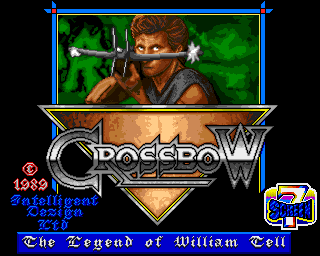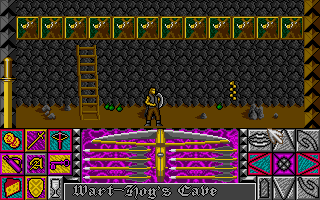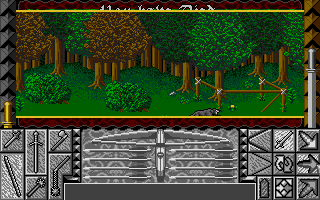Retro Replay Review
Gameplay
The Legend of William Tell blends action and puzzle elements in a way that keeps players constantly engaged. You step into the shoes of the Swiss folk hero, William Tell, traversing dense forests, winding mountain paths, and the foreboding walls of Gessler’s strongholds. Exploration is at the heart of the experience: you’ll need to scout every nook and cranny for provisions, hidden items, and clues that will help you progress. These objects are not merely collectible fluff; they serve as puzzle components, bribes to gain favor with wary locals, or essential gear upgrades to bolster Tell’s survival prospects.
(HEY YOU!! We hope you enjoy! We try not to run ads. So basically, this is a very expensive hobby running this site. Please consider joining us for updates, forums, and more. Network w/ us to make some cash or friends while retro gaming, and you can win some free retro games for posting. Okay, carry on 👍)
Combat encounters are frequent and can quickly turn the tide if you handle them carelessly. The game’s icon-driven control scheme requires you to select your actions carefully: choose the “draw sword” or “block” icon for melee fights, or switch to the “crossbow” icon to trigger a tense first-person shooting segment. Timing matters—you’ll learn to anticipate black knight strikes, dodge vicious animal lunges, and conserve your life energy for the gauntlet ahead. Should you fall low on health, foraging for berries or looting bandit camps for provisions becomes a life-or-death priority.
Puzzles add a refreshing layer of cerebral challenge. Whether you’re figuring out how to bribe a suspicious villager, using a discarded key to open a hidden passage, or combining disparate items to fashion a makeshift grappling hook, these brain-teasers feel woven into the world rather than tacked onto the storyline. Success often hinges on experimentation and careful observation: a tossed coin might distract a guard, or a carved figurine might unlock a merchant’s cooperation. This synergy of action and puzzle-solving ensures that each new area offers something unexpected.
Graphics
Visually, The Legend of William Tell delivers an atmospheric trip to medieval Switzerland. Environmental backdrops showcase lush forests dappled with sunlight, moss-covered stone walls, and icy mountain passes that exude a sense of chill. The color palette is earthy and restrained, reinforcing the realism of a land under the shadow of oppression. Subtle weather effects—drifting fog in the woods, falling snow in the highlands—contribute to the mood, even if they occasionally tax older hardware.
Character sprites are meticulously crafted, with Tell’s distinctive green cloak fluttering behind him as he moves, and the black knights’ armor gleaming under torchlight. Animation cycles are smooth enough for their era: you’ll see sword swings arc convincingly, crossbow bolts fly in first-person mode, and animals react dynamically to your presence. Facial expressions during dialogue are basic but effective, lending personality to merchants, peasants, and adversaries alike.
While the interface leans heavily on icons, these are intuitive and clear in function. The icon bar remains unobtrusive, allowing the visuals to take center stage until you need to issue commands. Occasionally you might wish for a live cursor-based control, but the consistency of the icon-driven system ensures that you never lose track of your available actions. Overall, the graphics hold up well, striking a satisfying balance between functional clarity and period-appropriate artistry.
Story
Rooted in the lore of William Tell and inspired by the TV series Crossbow, the narrative thrust is both familiar and compelling. You start as a reluctant hero, thrust into conflict when Duke Gessler’s tyranny reaches a boiling point. From clandestine meetings with local rebels to daring infiltrations of garrisoned castles, the plot unfolds through a mix of in-game cutscenes and dialogue-driven exchanges, each underlining the stakes of your mission: liberate the Swiss people from Gessler’s grip.
Supporting characters enrich the storyline, from elderly villagers recounting legends of Switzerland’s past to sympathetic blacksmiths offering to forge improved weaponry. Side quests—such as rescuing captured hunters or retrieving stolen livestock—may seem tangential at first but often reward you with valuable items or new allies. These diversions reinforce the breadth of Gessler’s oppression and make your quest feel deeply personal.
The pacing is well calibrated: periods of stealth and conversation allow you to catch your breath before plunging back into high-tension combat or thorny puzzles. Though the overarching plot follows a predictable underdog-versus-tyrant arc, it is elevated by occasional moral choices and the sense that your actions have tangible consequences for the people of the land. Whether you’re rallying villagers to your cause or cutting down legions of knights, the story’s momentum rarely flags.
Overall Experience
The Legend of William Tell offers a rich, immersive journey that will appeal to fans of classic action-adventure titles. Its mix of environmental exploration, strategic icon-based combat, and thoughtful puzzles creates a satisfying loop of challenge and reward. While newer gamers might initially balk at the control scheme’s departure from direct-input action, patience and practice reveal a system that is both reliable and engaging.
Atmospherically, the game excels at evoking the rugged beauty of medieval Switzerland and the looming threat of Gessler’s regime. Sound effects—from the crack of a crossbow to the distant clang of armor—complement the visuals and heighten immersion. The narrative, though rooted in familiar heroic tropes, is told with enough nuance and side content to feel substantial rather than boilerplate.
Ultimately, The Legend of William Tell is a testament to thoughtful design from an era when developers experimented with combining genres. If you appreciate methodical puzzles, period storytelling, and icon-driven combat that demands planning over button-mashing, this title is well worth your attention. It may not be the flashiest game on the shelf, but its depth and character make it a memorable adventure for aficionados of classic action-puzzle hybrids.
 Retro Replay Retro Replay gaming reviews, news, emulation, geek stuff and more!
Retro Replay Retro Replay gaming reviews, news, emulation, geek stuff and more!








Reviews
There are no reviews yet.